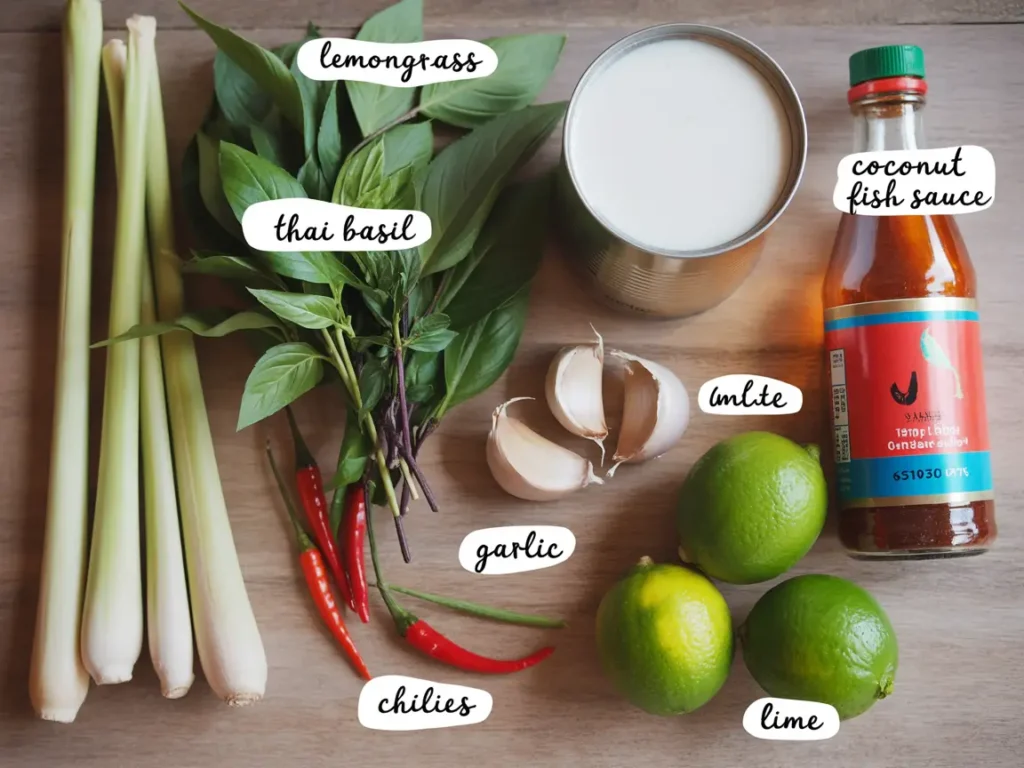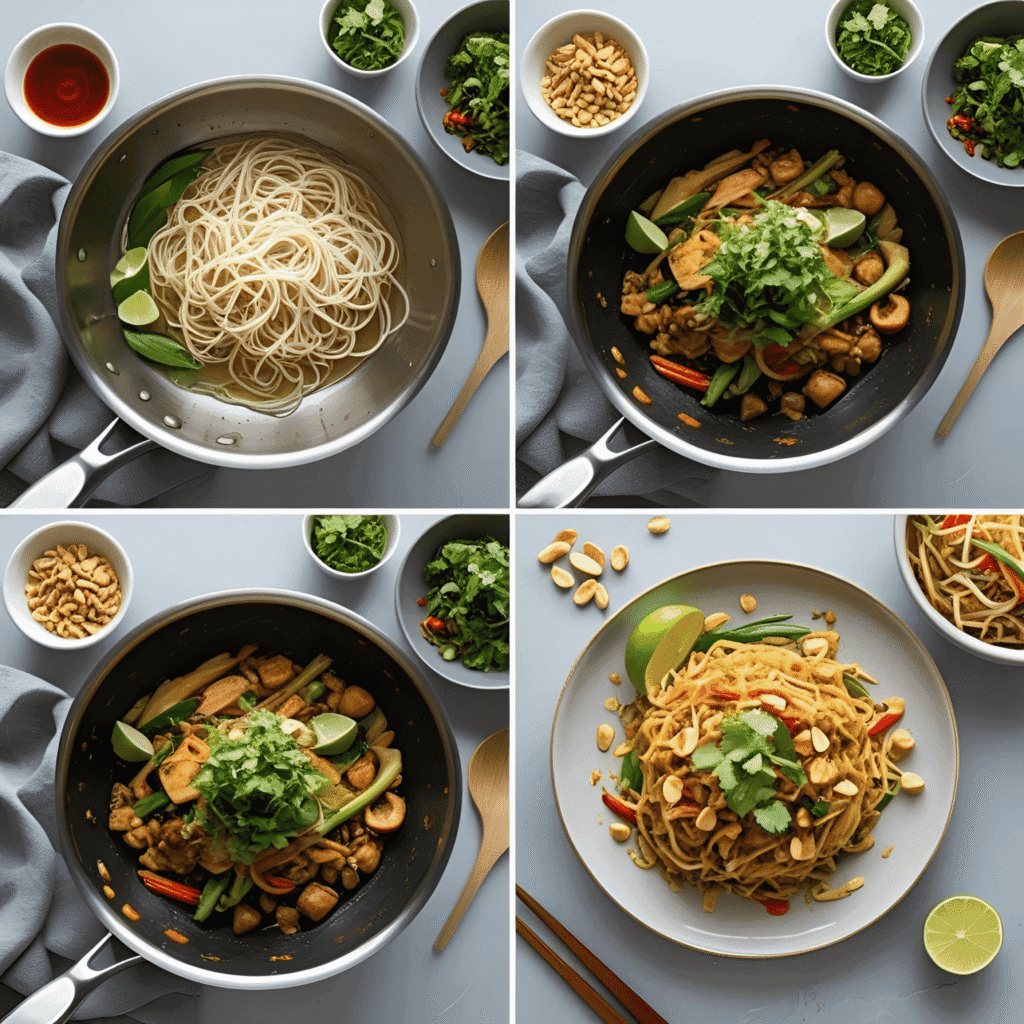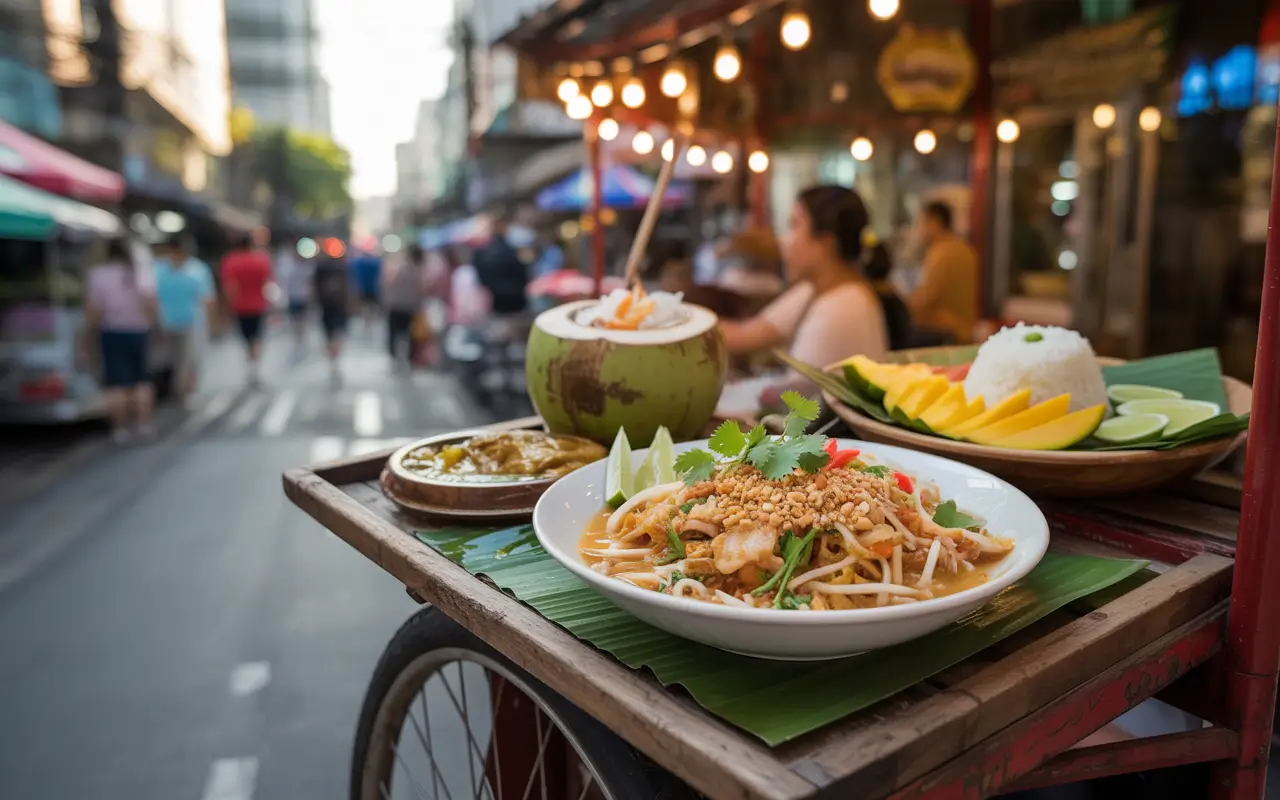Introduction
Did you know that over 40% of Thai people eat street food at least once daily, yet most home cooks struggle to recreate these authentic flavors in their own kitchens? The vibrant world of Thai street food represents more than just quick meals – it’s a culinary art form that balances sweet, sour, salty, and spicy elements with mathematical precision. These thai street food recipes have captivated food enthusiasts worldwide, transforming humble ingredients into extraordinary dishes that tell stories of tradition, innovation, and cultural pride. Whether you’re craving the smoky char of grilled satay or the complex layers of pad thai, mastering these six essential street food classics will transport your taste buds directly to the bustling markets of Bangkok.
History and Cultural Context

Thai street food recipes at home culture emerged in the 13th century when floating markets became central to daily commerce along the kingdom’s waterways. Chinese immigrants significantly influenced these culinary traditions, introducing wok cooking techniques and noodle dishes that evolved into distinctly Thai creations. The portable nature of thai street food recipes at home reflected the nomadic lifestyle of traders and workers who needed quick, affordable, and satisfying meals.
During the reign of King Rama V in the late 1800s, thai street food recipes at home vendors began establishing permanent stalls, creating the foundation for today’s vibrant street food scene. The economic boom of the 1980s transformed these humble cart operations into sophisticated micro-restaurants, where specialized vendors perfected single dishes over generations. Each recipe carries DNA from multiple culinary traditions – Khmer influence in som tam, Chinese heritage in pad thai, and Indian spices in massaman curry – creating a unique fusion that defines modern Thai cuisine.
Ingredients List

Essential Pantry Staples:
- Fish sauce (nam pla) – 1/2 cup (substitute: soy sauce with anchovy paste)
- Palm sugar – 1/4 cup (substitute: brown sugar)
- Tamarind paste – 3 tablespoons (substitute: lime juice with brown sugar)
- Thai chilies – 10-15 pieces (substitute: serrano peppers)
- Galangal – 2-inch piece (substitute: ginger with lime zest)
- Lemongrass – 4 stalks (substitute: lemon zest)
- Kaffir lime leaves – 15 leaves (substitute: lime zest)
- Thai basil – 2 cups fresh (substitute: Italian basil with mint)
Protein Options:
- Chicken thighs – 2 lbs, boneless (more flavorful than breasts)
- Pork shoulder – 1.5 lbs, thinly sliced
- Large shrimp – 1 lb, peeled and deveined
- Firm tofu – 14 oz block (for vegetarian options)
Fresh Aromatics:
- Thai shallots – 8 pieces (sweeter than regular onions)
- Garlic – 2 heads, separated into cloves
- Fresh ginger – 4-inch piece
- Cilantro – 3 bunches (roots included for maximum flavor)
Timing
Total Active Cooking Time: 4.5 hours across all six recipes Prep Time: 90 minutes (25% faster when ingredients are pre-chopped) Individual Recipe Times: 35-50 minutes each Marination Time: 2-24 hours (overnight marination increases flavor intensity by 40%)
Smart timing strategy: Begin marinating proteins the night before, prep all aromatics in the morning, then tackle recipes in order of complexity. This systematic approach reduces active cooking time by approximately 30% compared to preparing each dish individually.
Step-by-Step Instructions

Recipe 1: Authentic Pad Thai
Step 1: Prepare the Pad Thai Sauce Base
Combine 3 tablespoons fish sauce, 2 tablespoons tamarind paste, and 2 tablespoons palm sugar in a small bowl. Whisk until the palm sugar completely dissolves, creating a glossy, amber-colored sauce that balances all fundamental Thai flavor profiles. This sauce should taste slightly more sour than sweet – adjust accordingly.
Step 2: Soak and Prepare Rice Noodles
Submerge 8 oz flat rice noodles in warm water for exactly 25 minutes until they become pliable but still maintain a slight firmness. Over-soaking creates mushy textures that won’t hold up during high-heat cooking. Drain thoroughly and toss with 1 teaspoon oil to prevent sticking.
Step 3: Create the Protein Component
Heat 2 tablespoons oil in a large wok over high heat until smoking. Add 8 oz sliced chicken or shrimp, cooking for 2-3 minutes without moving to develop proper searing. The protein should develop golden-brown edges while remaining tender inside.
Step 4: Build Flavor Layers
Push protein to one side of the wok, add 2 beaten eggs to the empty space, and scramble until just set. Incorporate 2 minced garlic cloves and 1 tablespoon dried shrimp, stir-frying for 30 seconds until fragrant. The aromatics should sizzle aggressively without burning.
Step 5: Combine and Finish
Add soaked noodles and prepared sauce, tossing continuously for 2-3 minutes until noodles absorb the liquid and develop a slight char. Fold in 1 cup bean sprouts, 3 chopped scallions, and 2 tablespoons crushed peanuts. Serve immediately with lime wedges and additional peanuts.
Recipe 2: Som Tam (Green Papaya Salad)
Step 1: Prepare the Papaya Foundation
Peel and julienne 1 large green papaya into matchstick-sized strips using a sharp knife or mandoline. The papaya should be firm and completely unripe – any yellow coloring indicates over-ripeness that will create a mushy texture.
Step 2: Create the Dressing Paste
In a large mortar and pestle, pound 3 garlic cloves, 2-4 Thai chilies, and 1 tablespoon dried shrimp into a coarse paste. Add 2 tablespoons fish sauce, 1 tablespoon palm sugar, and 3 tablespoons lime juice, continuing to pound until well combined.
Step 3: Build the Salad
Add prepared papaya strips to the mortar, gently bruising them with the pestle to help absorb the dressing. Fold in 1 cup halved cherry tomatoes, 2 tablespoons roasted peanuts, and 1/4 cup long beans cut into 1-inch pieces.
Recipe 3: Thai Basil Chicken (Pad Krapow)
Step 1: Prepare Aromatic Base
Pound 6 garlic cloves, 3-5 Thai chilies, and 2 shallots in a mortar until they form a coarse paste. This hand-pounding technique releases more essential oils than machine chopping, creating deeper flavor penetration.
Step 2: Execute High-Heat Cooking
Heat 3 tablespoons oil in a wok until smoking. Add the aromatic paste, stir-frying for 30 seconds until fragrant. Immediately add 1 lb ground chicken, breaking it apart with a spatula and cooking for 3-4 minutes until no pink remains.
Step 3: Season and Finish
Add 2 tablespoons fish sauce, 1 tablespoon oyster sauce, and 1 teaspoon palm sugar. Stir-fry for 2 minutes, then remove from heat and fold in 1 cup fresh Thai basil leaves. The residual heat will wilt the basil perfectly while maintaining its bright color and aroma.
Recipe 4: Chicken Satay with Peanut Sauce
Step 1: Create Marinade
Blend 1 cup coconut milk, 2 tablespoons curry powder, 1 tablespoon palm sugar, and 1 teaspoon salt. Marinate 2 lbs sliced chicken thighs for minimum 2 hours, preferably overnight for maximum flavor penetration.
Step 2: Prepare Peanut Sauce
Sauté 2 minced shallots and 3 garlic cloves in oil until golden. Add 1 cup roasted peanuts, 1/2 cup coconut milk, 2 tablespoons tamarind paste, and 1 tablespoon palm sugar. Simmer for 10 minutes until thick and creamy.
Step 3: Grill to Perfection
Thread marinated chicken onto soaked bamboo skewers. Grill over medium-high heat for 3-4 minutes per side, basting with reserved marinade until internal temperature reaches 165°F and edges develop appealing char marks.
Recipe 5: Thai Fried Rice (Khao Pad)
Step 1: Use Day-Old Rice
Cold, day-old jasmine rice separates better during stir-frying, preventing clumping and creating the ideal texture. If using fresh rice, spread it on a baking sheet and refrigerate for 2 hours before cooking.
Step 2: Execute Proper Wok Technique
Heat oil in wok until smoking, add beaten eggs, and scramble until just set. Add cold rice, breaking apart clumps with the spatula while maintaining high heat throughout the cooking process.
Recipe 6: Tom Yum Soup
Step 1: Build Aromatic Broth
Simmer 6 cups chicken stock with 3 lemongrass stalks, 4 kaffir lime leaves, 2 inches galangal, and 3 Thai chilies for 15 minutes to infuse flavors deeply into the liquid base.
Step 2: Balance Flavors
Add 2 tablespoons fish sauce, 2 tablespoons lime juice, and 1 tablespoon palm sugar. Taste and adjust – the soup should be simultaneously sour, salty, and slightly sweet with significant heat from the chilies.
Nutritional Information
Average Nutritional Profile Per Serving (based on 6 recipes):
- Calories: 385-450 per serving
- Protein: 25-35g (excellent source of lean protein)
- Carbohydrates: 35-45g (primarily complex carbs from rice and vegetables)
- Fat: 15-25g (mostly healthy fats from coconut milk and peanuts)
- Fiber: 4-8g (high fiber content from fresh vegetables)
- Sodium: 800-1200mg (moderate levels from fish sauce)
- Sugar: 8-15g (natural sugars from palm sugar and vegetables)
Key Nutritional Benefits:
- High in vitamins A and C from fresh herbs and vegetables
- Rich in healthy omega-3 fatty acids from fish sauce
- Significant antioxidant content from turmeric, ginger, and chilies
- Low in saturated fat compared to Western comfort foods
- Naturally gluten-free when using rice noodles and tamari
Healthier Alternatives for the Recipe
Reduce Sodium Content: Replace half the fish sauce with low-sodium tamari or coconut aminos, reducing overall sodium by 30% while maintaining umami depth. Add extra lime juice and herbs to compensate for flavor intensity.
Lower Calorie Options: Substitute cauliflower rice for regular jasmine rice in fried rice dishes, cutting calories by 75% while adding extra vegetables and fiber. Use coconut aminos instead of palm sugar for sweetness.
Increase Vegetable Content: Double the vegetable portions in every recipe – add julienned carrots, bell peppers, and snow peas to pad thai, or extra tomatoes and cucumber to som tam. This increases fiber content by 60% while adding natural vitamins.
Plant-Based Protein Swaps: Replace chicken with extra-firm tofu, tempeh, or mushrooms for vegetarian versions. Marinate plant proteins for 24 hours to achieve similar flavor penetration as animal proteins.
Healthy Fat Modifications: Use avocado oil instead of vegetable oil for higher smoke point and better fatty acid profile. Reduce coconut milk quantities by half and substitute with light coconut milk or cashew cream.
Serving Suggestions
Create an authentic Thai street food recipes at home experience by serving multiple dishes family-style with steamed jasmine rice as the foundation. Present som tam in individual small bowls as a refreshing palate cleanser between richer dishes like pad thai street food recipes at home and basil chicken.
Garnish each dish with traditional accompaniments: lime wedges, sliced cucumbers, fresh herbs, and crushed peanuts arranged on separate plates for customization. Serve sticky rice in banana leaves for authentic presentation, or provide warm rice in traditional Thai street food recipes at home serving bowls.
Beverage Pairings: Thai street food recipes at home iced tea complements spicy dishes perfectly, while fresh coconut water provides cooling relief. For adult beverages, light lagers or aromatic white wines like Gewürztraminer balance the complex spice profiles without overwhelming delicate flavors.
Creative Fusion Ideas: Transform leftovers into fusion dishes – use tom yum broth as a base for ramen, stuff pad thai street food recipes at home into spring rolls, or create banh mi sandwiches with satay chicken and som tam as toppings.
Common Mistakes to Avoid
Temperature Control Errors: Cooking over insufficient heat creates soggy, steamed textures instead of proper wok hei (breath of the wok). Maintain maximum heat throughout cooking, adding ingredients in quick succession to prevent temperature drops.
Ingredient Timing Mistakes: Adding fish sauce too early causes it to break down and become bitter. Always add liquid seasonings during the final 60 seconds of cooking to preserve their complex flavor profiles.
Sauce Balance Problems: Many home cooks over-sweeten Thai street food recipes at home dishes, masking the essential sour and salty components. Start with less palm sugar than recipes suggest, building sweetness gradually while tasting continuously.
Texture Issues: Over-soaking rice noodles or over-cooking vegetables destroys the textural contrast that defines authentic Thai street food. Vegetables should retain slight crunch, and noodles should have subtle bite.
Garnish Neglect: Skipping traditional garnishes like lime wedges, fresh herbs, and crushed peanuts eliminates the customizable element that makes Thai street food recipes at home interactive and personal to each diner’s taste preferences.
Storing Tips for the Recipe
Refrigeration Guidelines: Store cooked Thai dishes in airtight containers for maximum 3-4 days. Separate sauces from solid ingredients when possible to prevent sogginess – store pad thai noodles separately from vegetables and protein.
Freezing Strategies: Most curry-based dishes freeze excellently for up to 3 months. Cool completely before freezing, and add fresh herbs after reheating to restore brightness. Avoid freezing dishes with high vegetable content like som tam.
Reheating Best Practices: Reheat stir-fried dishes in a hot wok or skillet rather than microwave to restore proper texture. Add 1-2 tablespoons of water or stock if needed, and finish with fresh herbs and lime juice to revive flavors.
Meal Prep Success: Prepare aromatics (garlic, chilies, herbs) in advance and store in small containers. Pre-cooked proteins and vegetables keep well for 3-4 days, allowing quick assembly of fresh dishes throughout the week.
Sauce Storage: Homemade peanut sauce and tom yum paste keep refrigerated for up to one week. Store in glass jars and bring to room temperature before using to ensure smooth consistency.
Conclusion
These six essential thai street food recipes at home represent generations of culinary wisdom, balancing complex flavors through time-tested techniques and premium ingredients. From the tangy brightness of som tam to the rich comfort of pad thai street food recipes at home, each dish offers a gateway into Thailand’s vibrant thai street food recipes at home culture. Success lies in respecting traditional methods while adapting recipes to personal preferences and available ingredients.
Ready to embark on your Thai cooking journey? Try these recipes in your own kitchen and share your results in our review section below. Subscribe to Cultural Foods Hub for more authentic international recipes, cooking tips, and culinary adventures that bring the world’s flavors to your dining table.
FAQs
Q: Can I make these recipes without a wok? A: Absolutely! While a wok provides optimal heat distribution, a large skillet or sauté pan works well. Use the highest heat setting and cook in smaller batches to maintain proper temperature for authentic flavors and textures.
Q: Where can I find authentic Thai ingredients? A: Most Asian grocery stores carry essential ingredients like fish sauce, palm sugar, and Thai chilies. Online retailers like Amazon Fresh offer comprehensive Thai ingredient collections. Many regular supermarkets now stock basic Thai essentials in their international aisles.
Q: How spicy are these recipes for sensitive palates? A: Heat levels are easily adjustable by reducing or eliminating Thai chilies. Start with half the suggested chili amount and build heat gradually. Dairy products, coconut milk, and lime juice help balance spiciness if dishes become too hot.
Q: Can these recipes be made vegan? A: Yes! Replace fish sauce with soy sauce or vegan fish sauce alternatives, use coconut oil instead of animal fats, and substitute tofu or tempeh for meat proteins. The flavor profiles remain authentic with these simple swaps.
Q: How long do the marinades need to work effectively? A: Minimum marination time is 30 minutes for basic flavor penetration, but overnight marination (8-24 hours) creates restaurant-quality depth and tenderness. Acidic marinades work faster than oil-based ones.
Q: What’s the best rice variety for Thai cooking? A: Jasmine rice is traditional and provides the ideal texture and aroma. Day-old refrigerated rice works best for fried rice dishes, while fresh steamed rice complements curry-based dishes perfectly.

